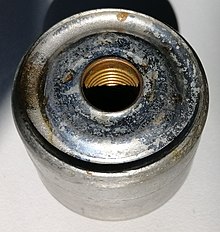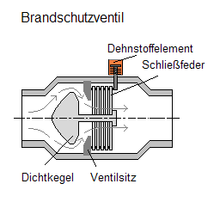Expansion element
The expansion element or expansion material working element denotes an actuator filled with expansion material and usually consists of a housing , a working piston and the expansion material.
function
The housing is filled with the expansion material, the filling consists of oil , wax , hard paraffin or metal , depending on the working temperature .
A material-dependent phase transition occurs due to a change in temperature . The expansion material experiences a significant change in volume . The change in volume is converted into a movement by appropriately designed housing.
The movement covered is proportional to the change in volume of the expansion material.
When the expansion material cools down again, the working piston is usually pushed back into the housing by a spring mechanism.
Since thermal energy is required for the phase transition at a typically constant temperature, the switching process lasts as long as the heat flow required for it.
By using a mixture of oils or waxes with different melting points, a switching range is defined over the melting interval . The same applies to metal alloys. Corresponding intermediate positions of the actuator are established for intermediate temperatures, which helps to avoid undesirable oscillations in the control loop and thus also mechanical wear on the piston.
The possible uses of expansion elements are in the temperature range from approximately −40 ° C to +180 ° C. The temperature for the start of the stroke development is determined by the expansion materials used.
Types
Mechanical structure of an expansion element.
- Version with membrane
- Version with elastomer insert
Applications
An example of the use of expansion elements is the thermostatic valve . In central heating systems or in sanitary technology with mixer taps, wax expansion elements help protect against scalding when showering. These expansion elements compensate for temperature fluctuations in fractions of a second.
Expansion elements are also known in cooling circuits of motor vehicles and in condensate drains as expansion body control valves, which automatically divert the condensate that forms in steam lines and forming processes into the pipeline or in the fire protection valve .




